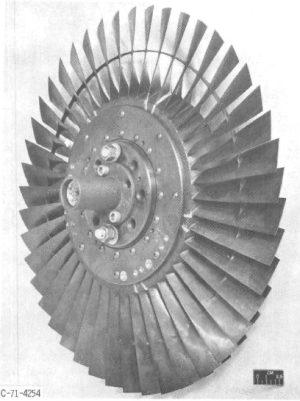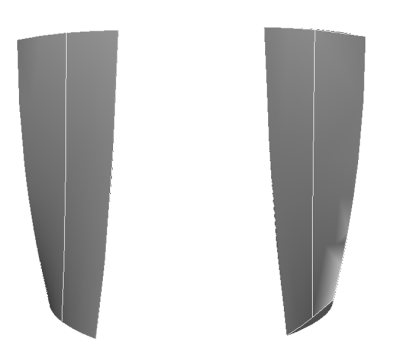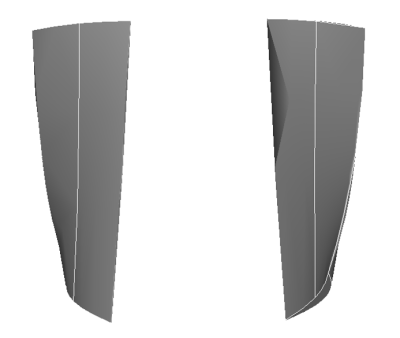Ceci est une ancienne révision du document !
Rotor 11
Original model
Rotor 11 is part of a research program to study the effect of weight flow per unit annulus area on the performance of axial-flow fan stages. A series of three stage: rotor 11, 16 and 17 were designed with a weight flow per unit annulus area of 198, 178, and 208 kilograms per second per square meter. All three stages were designed to produce a pressure ratio of 1.57, and all had the same meridional flow path geometry.
- Original technical report [1]:
@TechReport{kovich1973design, author = {Kovich, George. and Moore, R. D. and Urasek, Donald C.}, title = {Performance of transonic fan stage with weight flow per unit annulus area of 198 kilograms per sercond per square meter (40.6 (lb/sec)/ft²)}, institution = {NASA Lewis Research Center Cleveland, OH, United States}, note = {NASA-TM X-2905, url~: \url{https://ntrs.nasa.gov/citations/19740001915}, 1973 }} - Picture :
Useful documents
- PDF of the NASA report : rotor11.pdf
- CSV file of the blade geometry : rotor11_original.csv
Geometry
The geometry of rotor 11 is described in the original NASA report by the following tables. The length are in centimeters and the angles in degrees.

Aerodynamic design
| unit | values | |
|---|---|---|
| pressure ratio | [-] | 1.57 |
| mass flow | [kg/s] | 29.5 |
| tip speed | [m/s] | 425 |
| tip solidity | [-] | 1.3 |
| aspect ratio | [-] | 2.5 |
| number of blades | [-] | 44 |
| rotative speed | [rad/s] | 1686 |
Material properties
The original material of the rotor 11 is not defined in the NASA report.
Considered properties: Ti-6Al-4V, generic titanium :
| unité | valeurs | |
|---|---|---|
| alloy | [-] | Ti-6Al-4V |
| Young's modulus | [GPa] | 108 |
| density | [kg/m3] | 4400 |
| Poisson's ratio | [-] | 0.34 |
| yield stress | [GPa] | 0.824 |
First three natural frequencies (with clamped root) for the mesh:
- (1B): 1349.9 rad/s / 214.8 Hz
- (2B): 5271.3 rad/s / 838.9 Hz
- (1T): 7863.9 rad/s / 1251.6 Hz
CAD
Modèle original
Le rotor 11 fait partie d'un programme de recherche visant à étudier l'effet du débit massique par unité de surface annulaire sur les performances des soufflantes à flux axiaux. Une série de trois étages comprenant le rotor 11, 16 et 17 ont été conçus avec un débit massique par unité de surface annulaire de 198, 178 et 208 kilogrammes par seconde par mètre carré. Les trois étages ont été conçus pour produire un rapport de pression de 1.57.
* Rapport technique original [1]:
@TechReport{kovich1973design,
author = {Kovich, George. and Moore, R. D. and Urasek, Donald C.},
title = {Performance of transonic fan stage with weight flow per unit annulus area of 198 kilograms per sercond per square meter (40.6 (lb/sec)/ft²)},
institution = {NASA Lewis Research Center Cleveland, OH, United States},
note = {NASA-TM X-2905, url~: \url{https://ntrs.nasa.gov/citations/19740001915}, 1973 }}
- Photographie :
Documents utiles
- PDF du rapport de la NASA : rotor11.pdf
- Fichier CSV de la géométrie : rotor11_original.csv
Géométrie
La géométrie du rotor 11 est décrite dans le rapport d'origine de la NASA par les tableaux suivants. Les grandeurs sont en centimètres et en degrés.
Caractéristiques aérodynamiques
| unités | valeurs | |
|---|---|---|
| taux de compression | [-] | 1,57 |
| débit massique | [kg/s] | 29,5 |
| vitesse en tête | [m/s] | 425 |
| solidité en tête | [-] | 1,3 |
| allongement | [-] | 2,5 |
| nombre d'aubes | [-] | 44 |
| vitesse de rotation | [rad/s] | 1686 |
Propriétés matériau
Le matériau original du rotor 11 n'est pas défini dans le rapport de la NASA.
Propriétés considérées : alliage de titane Ti-6Al-4v :
| unité | valeurs | |
|---|---|---|
| alliage | [-] | Ti-6Al-4v |
| module d'Young | [GPa] | 108 |
| masse volumique | [kg/m3] | 4400 |
| coefficient de Poisson | [-] | 0,34 |
| limite élastique | [GPa] | 0,824 |
Fréquences des trois premiers modes (noeuds de la base encastrés) pour le maillage :
- (1B): 1349,9 rad/s / 214,8 Hz
- (2B): 5271,3 rad/s / 838,9 Hz
- (1T): 7863,9 rad/s / 1251,6 Hz


